Abstract
Barbiturates enhance the binding of [3H]diazepam to benzodiazepine receptor sites in rat brain. This effect occurs at pharmacologically relevant concentrations of barbiturates, and the relative activity of a series of compounds correlates highly with anesthetic activity of the barbiturates and with their ability to enhance postsynaptic inhibitory responses to the neurotransmitter gamma-aminobutyric acid. Barbiturate enhancement of benzodiazepine binding is stereospecific, with the more active anesthetic isomers of N1-methylbarbiturates being also more active than their stereoisomers in enhancing benzodiazepine binding. The active barbiturates produce a reversible enhancement in the affinity of specific benzodiazepine binding with no effect on the number of binding sites. The barbiturate enhancement, but not the baseline benzodiazepine binding, is competitively inhibited by the convulsant picrotoxinin (at 1-10 microM), a drug that has been shown to label barbiturate-sensitive brain membrane sites related to the gamma-aminobutyric acid receptor-ionophore complex. The barbiturate effect is also dependent upon the presence of certain anions, and only those anions, that penetrate the chloride channels regulated by gamma-aminobutyric acid receptors. These results suggest that picrotoxin-sensitive barbiturate binding sites are coupled to benzodiazepine receptors in the gamma-aminobutyric acid receptor-ionophore complex, and that these binding sites have the properties of pharmacologically relevant receptors that mediate at least part of the action of various nervous system depressant and excitatory drugs.
Full text
PDF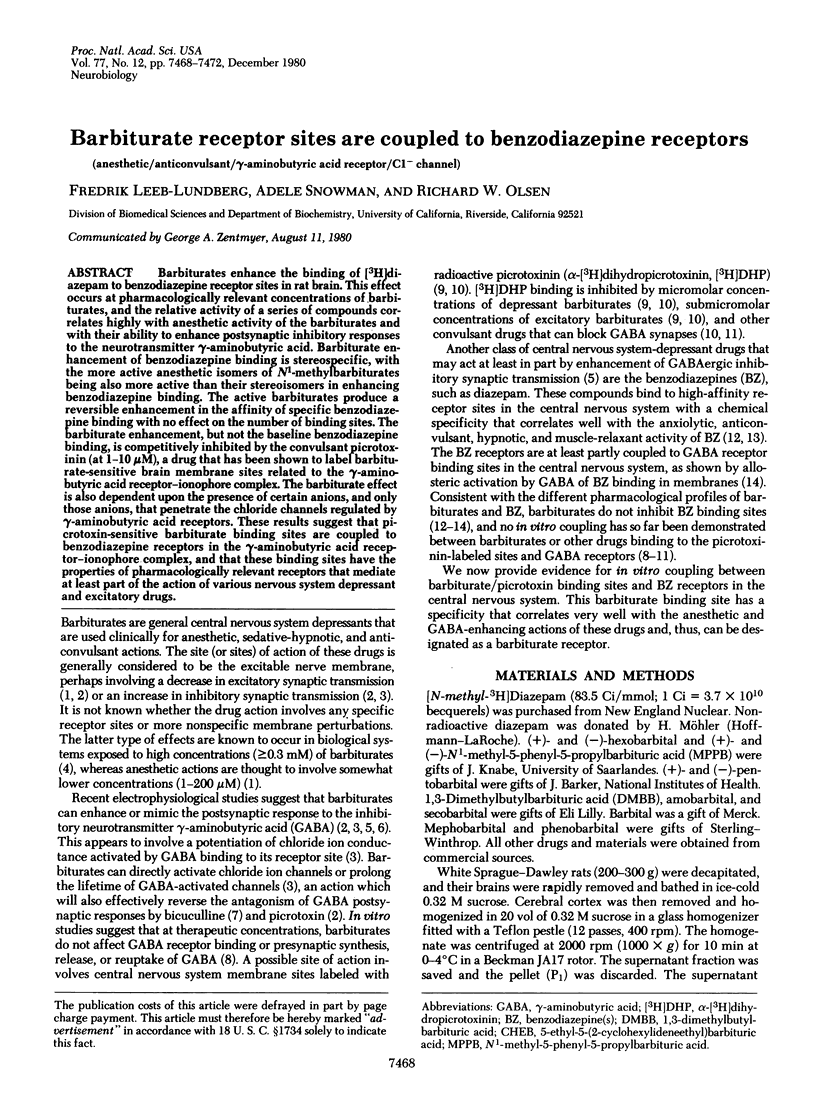
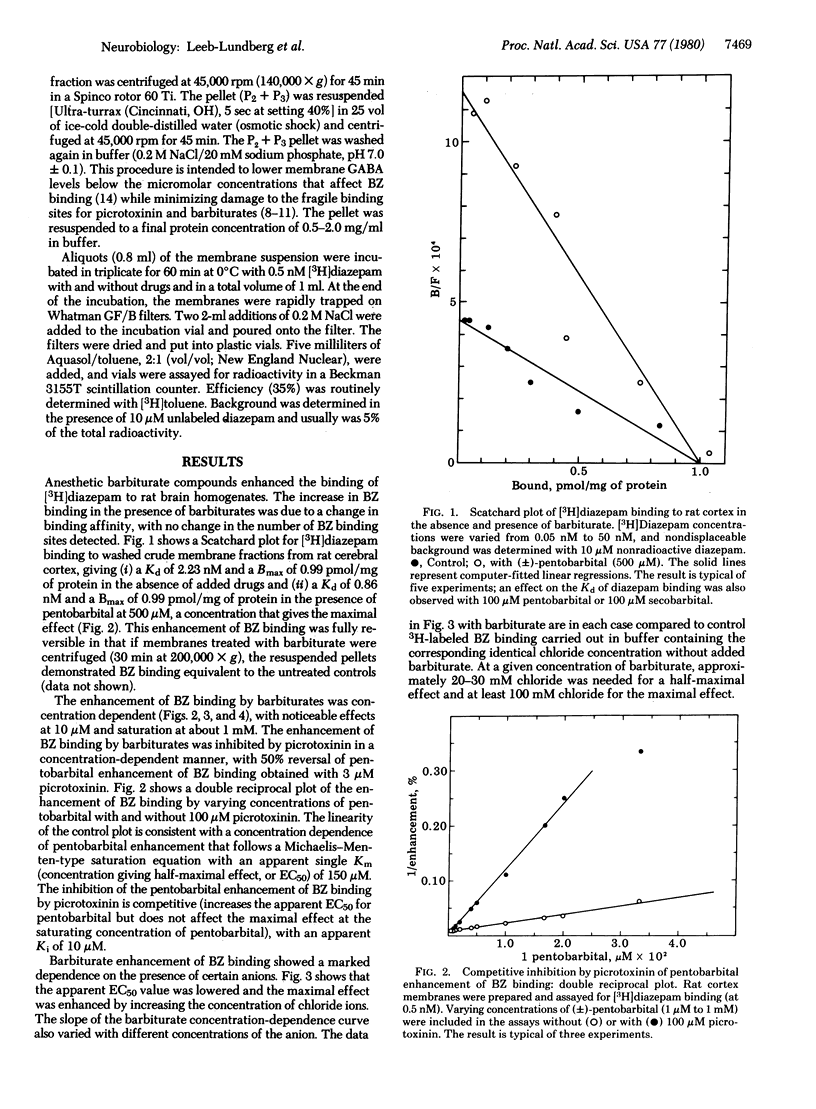
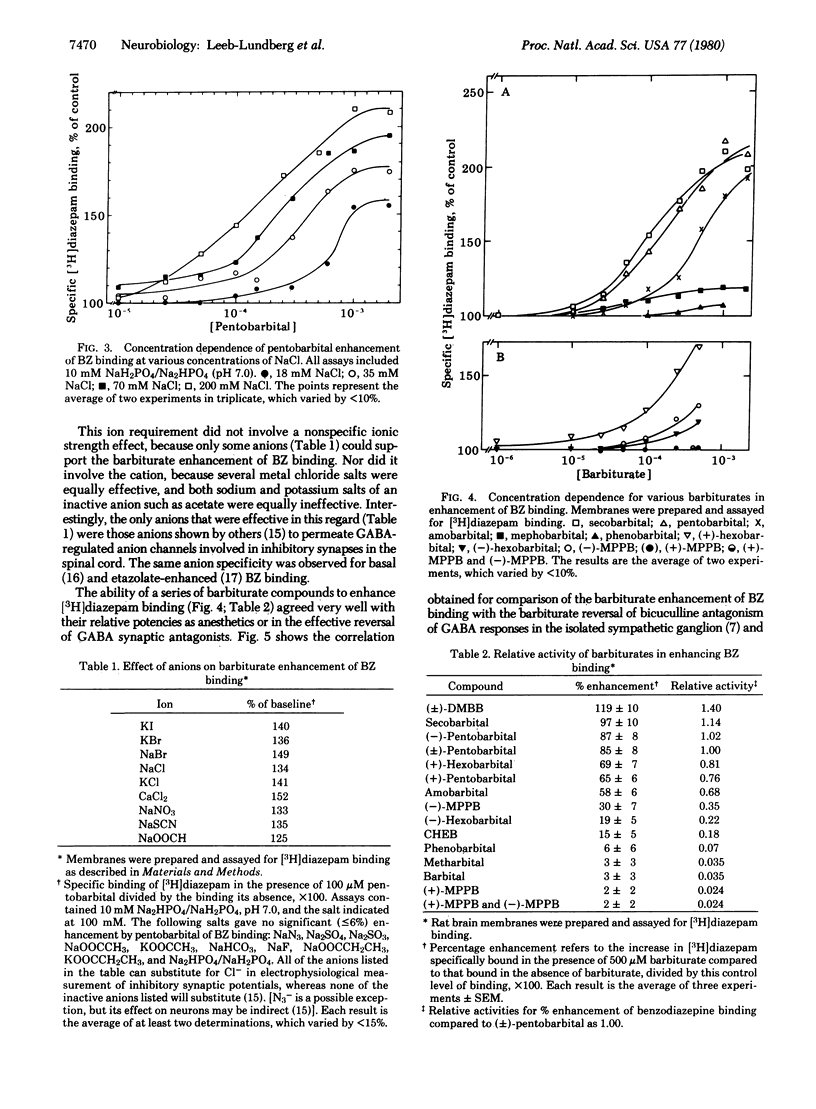
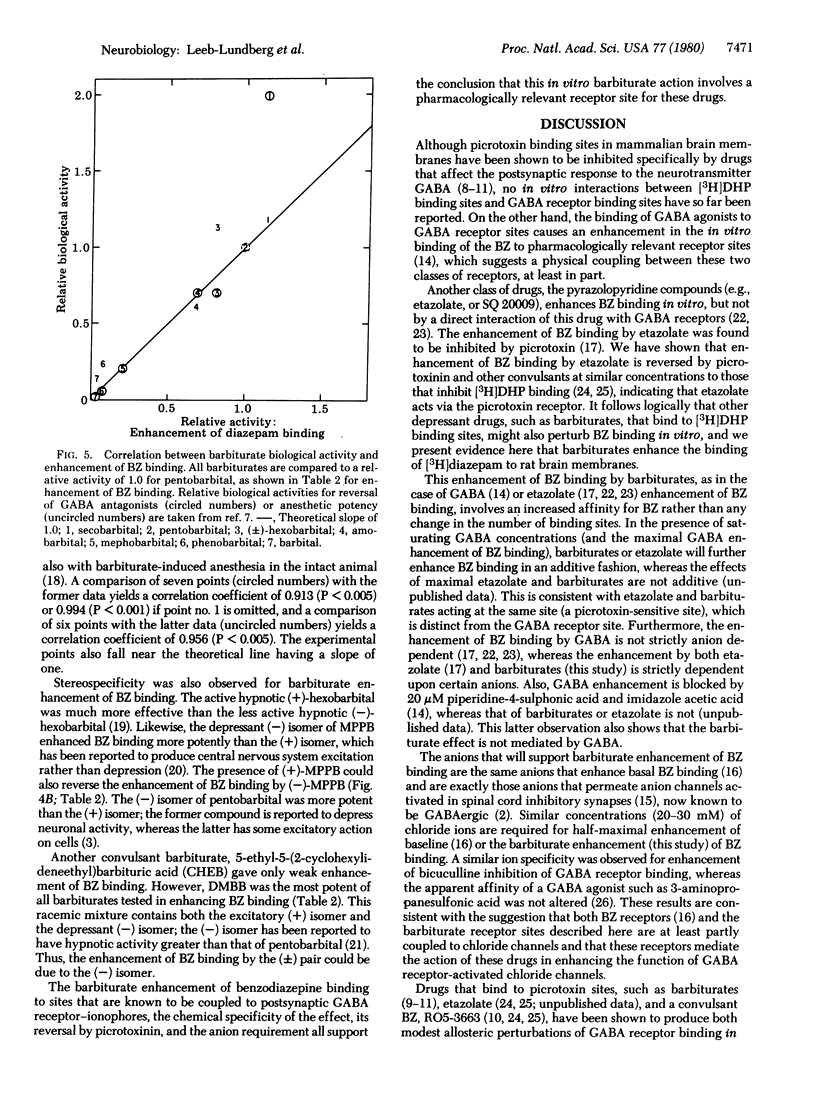
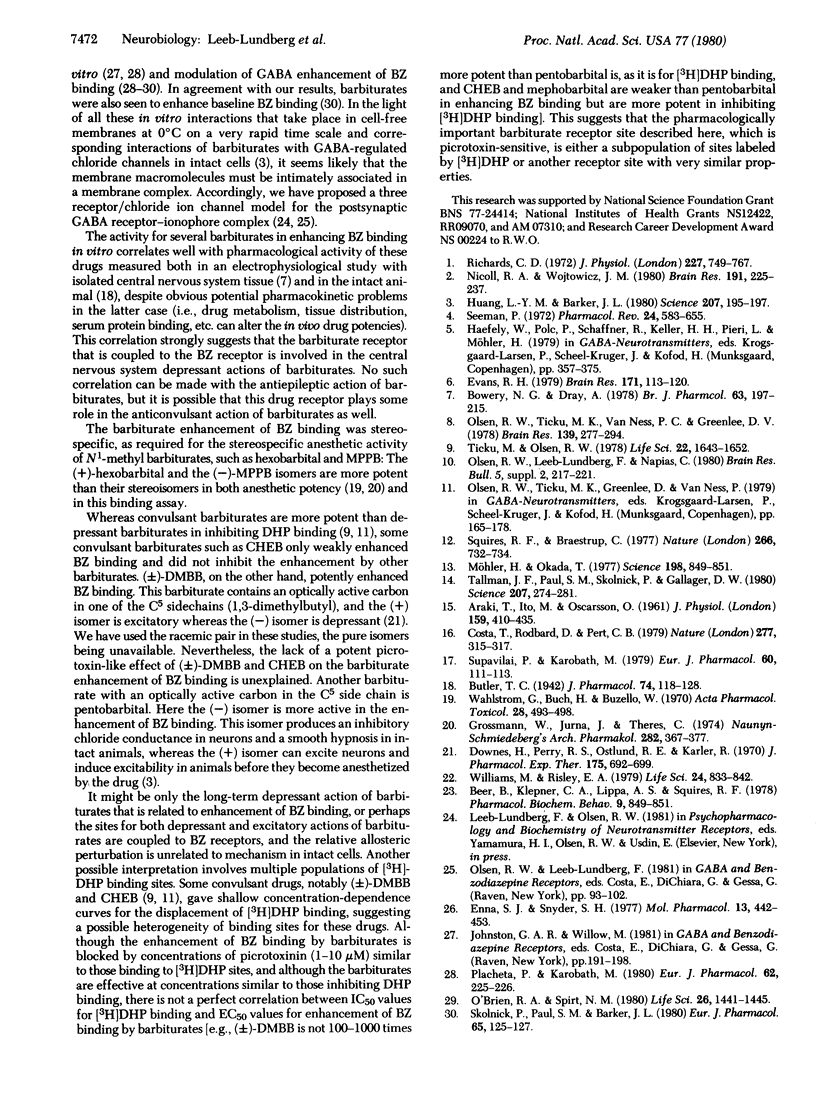
Selected References
These references are in PubMed. This may not be the complete list of references from this article.
- ARAKI T., ITO M., OSCARSSON O. Anion permeability of the synaptic and non-synaptic motoneurone membrane. J Physiol. 1961 Dec;159:410–435. doi: 10.1113/jphysiol.1961.sp006818. [DOI] [PMC free article] [PubMed] [Google Scholar]
- Beer B., Klepner C. A., Lippa A. S., Squires R. F. Enhancement of 3H-diazepam binding by SQ 65,396: a novel anti-anxiety agent. Pharmacol Biochem Behav. 1978 Dec;9(6):849–851. doi: 10.1016/0091-3057(78)90367-2. [DOI] [PubMed] [Google Scholar]
- Bowery N. G., Dray A. Reversal of the action of amino acid antagonists by barbiturates and other hypnotic drugs. Br J Pharmacol. 1978 May;63(1):197–215. doi: 10.1111/j.1476-5381.1978.tb07790.x. [DOI] [PMC free article] [PubMed] [Google Scholar]
- Costa T., Rodbard D., Pert C. B. Is the benzodiazepine receptor coupled to a chloride anion channel? Nature. 1979 Jan 25;277(5694):315–317. doi: 10.1038/277315a0. [DOI] [PubMed] [Google Scholar]
- Downes H., Perry R. S., Ostlund R. E., Karler R. A study of the excitatory effects of barbiturates. J Pharmacol Exp Ther. 1970 Dec;175(3):692–699. [PubMed] [Google Scholar]
- Enna S. J., Snyder S. H. Influences ions, enzymes, and detergents on gamma-aminobutyric acid-receptor binding in synaptic membranes of rat brain. Mol Pharmacol. 1977 May;13(3):442–453. [PubMed] [Google Scholar]
- Evans R. H. Potentiation of the effects of GABA by pentobarbitone. Brain Res. 1979 Jul 27;171(1):113–120. doi: 10.1016/0006-8993(79)90736-4. [DOI] [PubMed] [Google Scholar]
- Grossmann W., Jurna I., Theres C. The site of action of the optical isomers of 1-methyl-5-phenyl-5-propyl barbituric acid. Naunyn Schmiedebergs Arch Pharmacol. 1974;282(4):367–367. doi: 10.1007/BF00500985. [DOI] [PubMed] [Google Scholar]
- Huang L. Y., Barker J. L. Pentobarbital: stereospecific actions of (+) and (-) isomers revealed on cultured mammalian neurons. Science. 1980 Jan 11;207(4427):195–197. doi: 10.1126/science.7350656. [DOI] [PubMed] [Google Scholar]
- Möhler H., Okada T. Benzodiazepine receptor: demonstration in the central nervous system. Science. 1977 Nov 25;198(4319):849–851. doi: 10.1126/science.918669. [DOI] [PubMed] [Google Scholar]
- Nicoll R. A., Wojtowicz J. M. The effects of pentobarbital and related compounds on frog motoneurons. Brain Res. 1980 Jun 2;191(1):225–237. doi: 10.1016/0006-8993(80)90325-x. [DOI] [PubMed] [Google Scholar]
- O'Brien R. A., Spirt N. M. The inhibition of GABA-stimulated benzodiazepine binding by a convulsant benzodiazepine. Life Sci. 1980 Apr 28;26(17):1441–1445. doi: 10.1016/0024-3205(80)90047-8. [DOI] [PubMed] [Google Scholar]
- Olsen R. W., Ticku M. K., Van Ness P. C., Greenlee D. Effects of drugs on gamma-aminobutyric acid receptors, uptake, release and synthesis in vitro. Brain Res. 1978 Jan 13;139(2):277–294. doi: 10.1016/0006-8993(78)90929-0. [DOI] [PubMed] [Google Scholar]
- Placheta P., Karobath M. In vitro modulation by SQ 20009 and SQ 65396 of GABA receptor binding in rat CNS membranes. Eur J Pharmacol. 1980 Mar 21;62(2-3):225–228. doi: 10.1016/0014-2999(80)90281-2. [DOI] [PubMed] [Google Scholar]
- Richards C. D. On the mechanism of barbiturate anaesthesia. J Physiol. 1972 Dec;227(3):749–767. doi: 10.1113/jphysiol.1972.sp010057. [DOI] [PMC free article] [PubMed] [Google Scholar]
- Seeman P. The membrane actions of anesthetics and tranquilizers. Pharmacol Rev. 1972 Dec;24(4):583–655. [PubMed] [Google Scholar]
- Skolnick P., Paul S. M., Barker J. L. Pentobarbital potentiates GABA-enhanced [3H]-diazepam binding to benzodiazepine receptors. Eur J Pharmacol. 1980 Jul 11;65(1):125–127. doi: 10.1016/0014-2999(80)90222-8. [DOI] [PubMed] [Google Scholar]
- Squires R. F., Brastrup C. Benzodiazepine receptors in rat brain. Nature. 1977 Apr 21;266(5604):732–734. doi: 10.1038/266732a0. [DOI] [PubMed] [Google Scholar]
- Supavilai P., Karobath M. Stimulation of benzodiazepine receptor binding by SQ 20009 is chloride-dependent and picrotoxin-sensitive. Eur J Pharmacol. 1979 Nov 23;60(1):111–113. doi: 10.1016/0014-2999(79)90060-8. [DOI] [PubMed] [Google Scholar]
- Tallman J. F., Paul S. M., Skolnick P., Gallager D. W. Receptors for the age of anxiety: pharmacology of the benzodiazepines. Science. 1980 Jan 18;207(4428):274–281. doi: 10.1126/science.6101294. [DOI] [PubMed] [Google Scholar]
- Ticku M. K., Olsen R. W. Interaction of barbiturates with dihydropicrotoxinin binding sites related to the GABA receptor-ionophore system. Life Sci. 1978 May 8;22(18):1643–1651. doi: 10.1016/0024-3205(78)90061-9. [DOI] [PubMed] [Google Scholar]
- Wahlström G., Büch H., Buzello W. Unequal anaesthetic potency despite equal brain concentration of hexobarbital antipodes. Acta Pharmacol Toxicol (Copenh) 1970;28(6):493–498. doi: 10.1111/j.1600-0773.1970.tb00575.x. [DOI] [PubMed] [Google Scholar]
- Williams M., Risley E. A. Enhancement of the binding of 3H-diazepam to rat brain membranes in vitro by SQ 20009, A novel anxiolytic, gamma-aminobutyric acid (GABA) and muscimol. Life Sci. 1979 Feb 26;24(9):833–841. doi: 10.1016/0024-3205(79)90367-9. [DOI] [PubMed] [Google Scholar]


